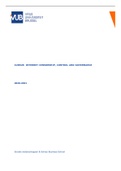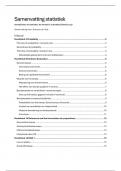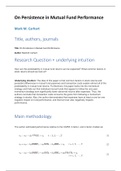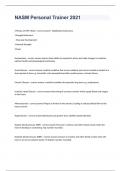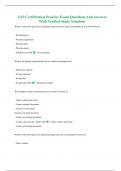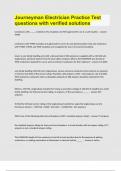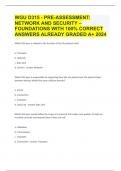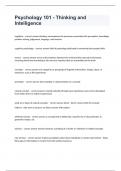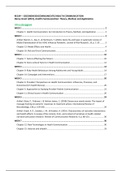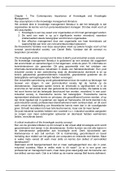2020-2021
Sociale wetenschappen & Solvay Business School
,INHOUDSOPGAVE
1 History of the Internet: technical and governance principles ................................................................... 4
1.1.1 Declaration of independence of cyberspace ..................................................................................... 4
1.1.2 History of the internet ....................................................................................................................... 4
1.1.3 Central governance principle of the early internet ........................................................................... 5
1.1.4 Changing governance ........................................................................................................................ 6
1.1.5 Central Technical principle of the early internet ............................................................................... 7
1.1.6 Changing architecture ....................................................................................................................... 7
2 Theorizing Internet governance ............................................................................................................. 11
2.1.1 Introduction .................................................................................................................................... 11
2.1.2 Theorizing internet governance ...................................................................................................... 11
2.1.3 Defining Internet governance ......................................................................................................... 13
2.1.4 Conclusion ....................................................................................................................................... 15
3 Internet governance institutions: ITU, IGF and ICANN (Gulyás, Tjahja, Peake) ....................................... 17
4 Disinformation and election integrity .................................................................................................... 19
4.1.1 Defining disinformation................................................................................................................... 19
4.1.2 Defining (Internet) governance ....................................................................................................... 19
4.1.3 Defining technological governance ................................................................................................. 20
4.1.4 Digital Election campaigns .............................................................................................................. 20
4.1.5 From ad hoc approaches ................................................................................................................. 20
4.1.6 To a focus on transparency ............................................................................................................. 21
4.1.7 And banning pol ads ........................................................................................................................ 21
4.1.8 Digital election campaigns .............................................................................................................. 22
4.1.9 From investigations ......................................................................................................................... 22
4.1.10 On regulating tech platforms ...................................................................................................... 22
4.1.11 To enforcement and legislation .................................................................................................. 23
4.1.12 Legislative, pre-legislative and policy responses ........................................................................ 24
4.1.13 Curatorial responses ................................................................................................................... 24
4.1.14 Problems and solutions............................................................................................................... 25
4.1.15 Conclusion (my 2min take on platform governance) .................................................................. 25
5 European perspectives on Internet governance ..................................................................................... 27
6 Surveillance and privacy NB. Want to change to copyright? .................................................................. 29
6.1.1 Transparency and privacy in the digital world ................................................................................ 29
2
, 6.1.2 Defending privacy............................................................................................................................ 29
6.1.3 Privacy as a primary or a secondary right? ..................................................................................... 30
6.1.4 Distinction between public and private spheres ............................................................................. 30
6.1.5 (very) brief History of privacy .......................................................................................................... 30
6.1.6 Types of Privacy ............................................................................................................................... 31
6.1.7 Everyday Surveillance...................................................................................................................... 31
6.1.8 Corporate surveillance .................................................................................................................... 32
6.1.9 Privacy in legislation ........................................................................................................................ 32
6.1.10 Privacy online .............................................................................................................................. 33
7 Censorship and control (Part 1).............................................................................................................. 35
7.1.1 Government Control ....................................................................................................................... 35
8 Censorship and control (Part 2).............................................................................................................. 43
8.1.1 Government Censorship ................................................................................................................. 43
8.1.2 FOTN Scores .................................................................................................................................... 46
8.1.3 Government Control ....................................................................................................................... 46
8.1.4 Declaration of Independence of cyberspace ................................................................................... 52
9 Cyber-diplomacy and cyber-security ...................................................................................................... 53
10 Future of Internet governance ........................................................................................................... 55
10.1.1 Intergovernmental // Multistakeholder institutions .................................................................. 55
10.1.2 Multistakeholder vs. (inter)governmental governance .............................................................. 55
10.1.3 Un secretary-general’s high-level panel on digital cooperation ................................................. 56
10.1.4 A. Digital Commons Architecture ................................................................................................ 56
10.1.5 B. Distributed Co-Governance .................................................................................................... 57
10.1.6 C. Internet Governance Forum + ................................................................................................ 57
10.1.7 Cyber governance and the moral limit of the market ................................................................ 58
10.1.8 Global commission on internet governance ............................................................................... 58
10.1.9 The future of digital governance................................................................................................. 59
11 Example questions ............................................................................................................................. 61
3
,1 HISTORY OF THE INTERNET: TECHNICAL AND GOVERNANCE
PRINCIPLES
1.1.1 Declaration of independence of cyberspace
John Perry Barlows - 1996
Governments of the Industrial World, you weary giants of flesh and steel, I come
from Cyberspace, the new home of Mind. On behalf of the future, I ask you of the
past to leave us alone. You are not welcome among us. You have no sovereignty
where we gather.
We are creating a world where anyone, anywhere may express his or her beliefs,
no matter how singular, without fear of being coerced into silence or conformity.
You have no moral right to rule us nor do you possess any methods of enforcement
we have true reasons to fear.
In China, Germany, France, Russia, Singapore, Italy and the United States, you
are trying to ward off the virus of liberty by erecting guard posts at the frontiers
of Cyberspace. They may keep out the contagion for a small time, but they will
not work in a world that will soon be blanketed in bit-bearing media.
• Founder of Electronic Freedom Foundation (EFF)
• Declaration in 1996
o Early reflections on Internet as separate space
o Focus on government intervention
1.1.2 History of the internet
Early internet – internet until 1990s
• Invented and used by scientists, hobbyists, hackers
• Seen as a neutral space – Government support/direction, but no intervention
(slightly different in Europe, see W5)
4
,Internet until 2000s
• Explosion of users - Graphic browser - hypertext
• Commercialization of the Internet
Internet until today
• Web 2.0 and social media
• Mobile revolution
User groups and rationales
1.1.3 Central governance principle of the early internet
Rough consensus
“We reject kings, presidents and voting. We believe in rough consensus and
running code.”
Network management: Request for Comments
• Publication of a document in order to receive comments and feedback
(exchange and collaboration)
• Informal use by early engineers (Crocker and Cerf at Stanford)
• Adopted in 1985 by the Internet Engineering Task Force (IETF)
• Community governance: Netiquette
5
,• E.g. avoiding ‘flaming’: increasingly hostile and insulting interactions among
participants in e-mail communications
1.1.4 Changing governance
Multilateral and multistakeholder
• Governance of the Internet has expanded drastically since 1990s
• Overlap and fragmentation
o In governance approaches
o Across layers, policy areas, sectors
o Between actors, countries, institutions
• Renewed discussion on universal Internet values
o E.g. “Inclusiveness, respect, human centredness, human flourishing,
transparency, collaboration, accessibility, sustainability, harmony” (UN
High-Level Panel on Digital Cooperation, 2019, The Age of Digital
Interdependence, p.7)
• Does not prevent aggressive state and corporate behavior
6
,Un high-level panel on digital cooperation
1.1.5 Central Technical principle of the early internet
End-to-end principle
• Put intelligence near end points (terminals)
• Leave network dumb
Result of this principle
• No interference when info travels from A to B
o Commercial/non-Commercial information treated identical
o Text, Voice, Video treated identical
• Has resulted in enormous innovation and freedom
o Google, Facebook, YouTube, Pirate Bay, Wikipedia etc.
o Blogs, Discussion Forums, chatrooms
( -> Interrelated principles: Openness, Interoperability, Redundancy)
1.1.6 Changing architecture
Market control
• More possibilities to control access & behavior
Markets
• Mechanisms at level of infrastructure
o Closed Devices
o Network Management
7
, o Content Delivery Networks (CDNs)
• Mechanisms at level of services
o Platformization
Markets: Closed devices
• Computers – Generic devices
o Free to install OS, software, etc.
o Browsers give access to all available content
• New devices much more closed
o Gaming platforms Wii, Xbox, Playstation
o Mobile platforms: Apple App Store iPhone, iPad
— Editorial function - Selection of content
o TV new major battlefield for video
— Cable set top box, IP enabled TV, game platform, etc.
• What will become main entry point?
Markets: Network management
Internet
• Not meant for AV-distribution
• Growing traffic causes severe problem
Technical solutions
• Network management – Deep packet inspection
• Prioritization of certain content e.g. video conferencing
• Positive is better quality of service
Net neutrality debate
• Risk of misuse
o Paid traffic goes much faster – would disturb level playing field
o Prioritization/throttling of certain types of content - P2P services
8

